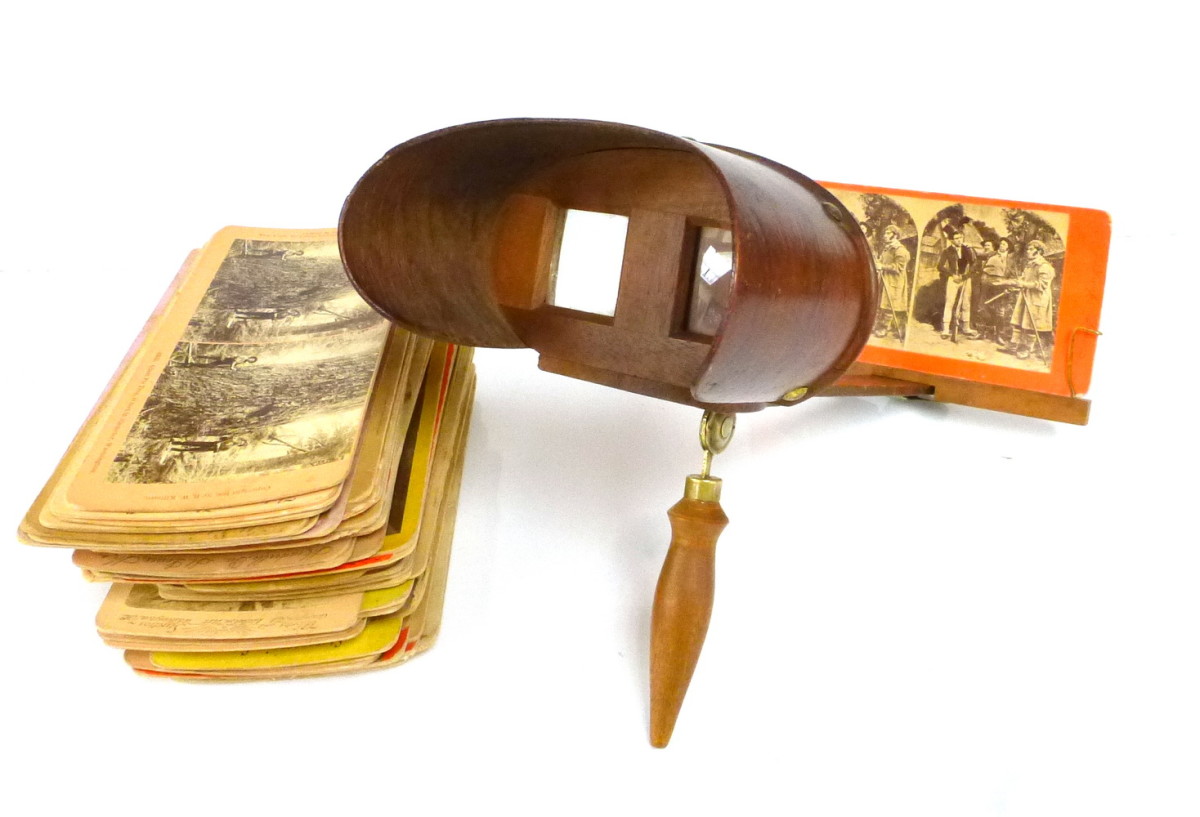Remembering the View-Master
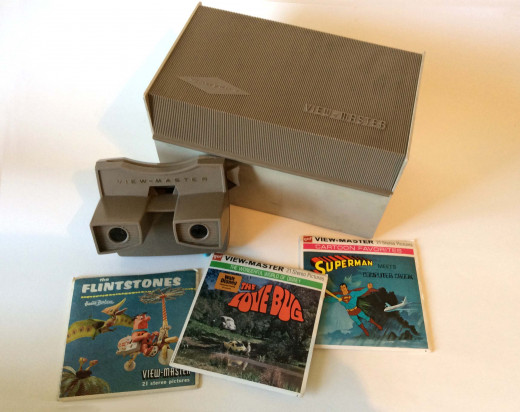
Do You Remember the View-Master?
Just about everyone who grew up during the 20th century remembers View-Master. Rotating kiosks of the newest reels were prominently positioned in most toy stores across the U.S. Packets featured scenes of the latest movies, TV shows and cartoon characters. A world of adventure awaited!
View-Master can be thought of as an early form of virtual reality. Images on the reels presented the best of photography, brilliant scene creation, masterful lighting and superb photography. By holding the View-Master up to the light, the user endowed the images with a certain brilliance and vividness that made them seem especially lifelike. They always represented the very best of stereo photography, little windows onto a special world that you were able to see only by looking through this magical viewer.
There were multiple ways to enjoy View-Master. You could just look at the pretty pictures, or you could read the brief caption that accompanied each image. If you were really ambitious, you could read the more detailed description of each scene in the little booklet that accompanied each set of View-Master reels.
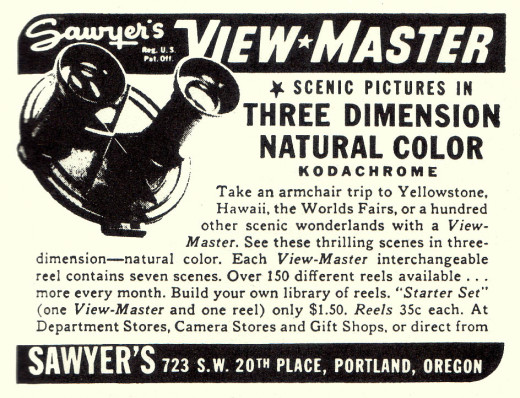
Precursor of the View-Master: The Stereoscope
View-Master was really the descendent of a series of competing methods of presenting stereo images, dating back to the old-fashioned stereoscope that grandmother used to have.
These stereoscopes, made of wood, presented scenes, usually in black-and-white, on sets of separate cards, each card holding two photographic views taken from slightly different angles, which created the stereoscopic effect. You slid a card into the viewer, and after viewing the scene, you lifted out the card and slid in the next one.
View-Master automated much of that. Rather than having to slide in and out a card each time, you merely pressed the lever to advance to the next scene – seven per reel. And, of course, all of the images on the View-Master were in vivid, glorious color.
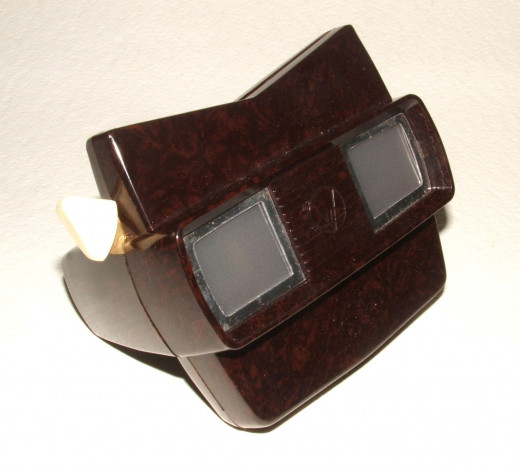
Origins of the View-Master
The name GAF is associated in most people’s minds with the View-Master, but the original marketer of the device was a company called Sawyer's, based in Portland Oregon. The first reels featured scenic views exclusively, with an emphasis on the Western half of the USA (unsurprisingly, considering the location of the manufacturer).
According to the book Amazing 3-D by Hal Morgan and Dan Symmes, Sawyer's was founded in 1914 by Carlton Sawyer and two partners as a photo-finishing service for a drug company. In 1919 it expanded to drugstores throughout the Pacific Northwest. After a while, it hit upon the idea of increasing its business by offering scenic postcards
The View-Master system was invented by William Gruber, a German immigrant, in 1938 using Kodachrome film, which was new at the time. Because they were half the width of standard 35mm film, the images on a View-Master reel cost half as much to make. Circular cards held the views, and a viewer with a simple advance mechanism rotated the cards, making it easy to switch from one view to the next.
Gruber met Harold Graves, who was president of Sawyer’s of the time, not by design but by a totally chance event – he was sightseeing at some Oregon caves and testing out a stereo camera of his own creation. Graves was intrigued by the device and struck up a conversation with him, During which he learned about Gruber’s View-Master concept. Shortly afterwards, talks followed on how Sawyer's could market Gruber’s new invention.
View-Master was introduced to the world with much fanfare at the1939 New York World's Fair, an event that appropriately enough showcased the exciting technologies of the future. Its theme was "Building The World Of Tomorrow.”
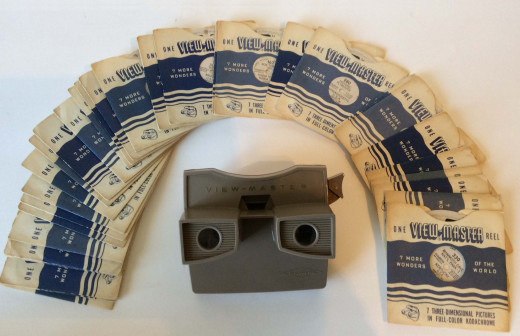
View-Master Comes of Age
The original viewers were hinged like a clamshell and had a small spindle inside over which the center hole of the circular card was placed. The first two models of View-Master, introduced in 1938 and 1944 respectively, were circular to match the shape of the reels and sold for $1.50 each.
Cards manufactured ever since retained the circular hole, even after the design of the View-Master changed with cards being inserted into the top slot, making all cards compatible with all viewers. In 1946, the first square, top-loading model came out.
During World War II, Sawyer's produced training reels for the US military, but by war’s end it had a good selection of commercial reels for the general public.
1946 saw the release of the much-loved fairy-tale reels, the artist of which was Florence Thompson, who used bits of wood, paper, plaster, paint, and dried flowers to create her magical scenes. Some of the earliest reels included Little Red Riding Hood, Hansel and Gretel and Snow White. Later reels included Little Black Sambo, The Three Little Pigs, The Ugly Duckling, The Elves and the Shoemaker, and Aesop's Fables.
In addition to views of the United States, after the war Sawyer's introduced reels featuring England, Switzerland, the Middle East and the West Indies. A popular series of Bible stories featured live actors.
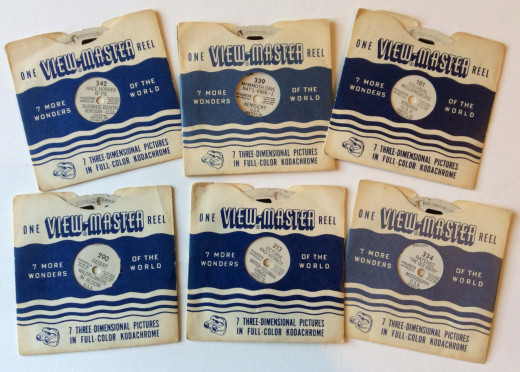
View-Master: The Later Years
Sawyer's, with a low price for both the reels in the viewer, brought stereo pictures back into the mainstream. Sales skyrocketed through the 1940s and 1950s.
In 1951, Sawyer's acquired Tru-Vue, a competing stereo viewer. With that, it got the rights to some of the views of Walt Disney Studios. In the same year, the company also started featuring views of licensed cartoon characters, such as Woody Woodpecker and Bugs Bunny. Personalities from TV and the movies also started to appear on the 3-D reels.
The Talking View-Master (in the pre-microchip era) actually used a battery-operated phonograph and miniature records to produce the audio. There were also battery-operated versions of the View-Master that contained their own light source.
View-Master was purchased by GAF (General Aniline & Film Corporation) in 1967 and the company was sold again in 1981. Now it is owned by the Fisher-Price division of toymaker Mattel.
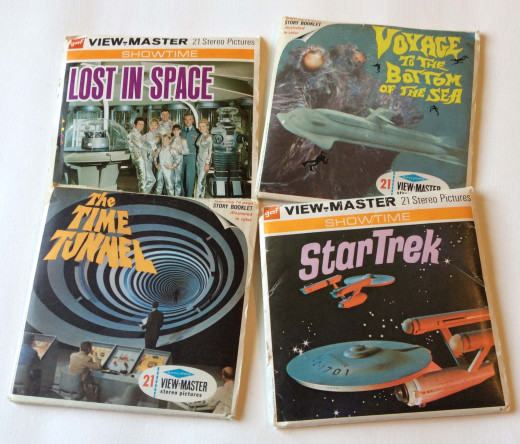
Popular TV Shows and Characters
The topics available for the View-Master covered a wide gamut. From the early 1950s, licensed cartoon characters were featured, and not long afterwards a wide range of favorite movies and TV shows started appearing on the popular reels.
The TV show reels used actual scenes taken during filming, and View-Master photographers with their stereo cameras were apparently given access to the soundstages as the episodes were being shot. Some purely fantasy subjects were created as 3-D models which were then photographed, while some of the cartoon based reels used drawn images that were given a 3-D look. Others, such as "Superman Meets Computer Crook" (1970), use a combination of both 3-D models for the settings and three-dimensionalized drawings for the characters themselves.
On the Superman reels, we see the story of our hero’s origins in the first few frames and then the story cuts to the present, as newspaper reporters Clark Kent and Lois Lane cover the "Moon Gem Depository" dedication. Mad scientist Mickro plans to steal a priceless gem with his robot, Computer Crook, and Superman has to rescue Lois Lane, who is kidnapped and locked in a bank vault. But Mickro causes a rockslide as a distraction while he and his robot rob the vault. In the end, Superman tunnels through and uses a giant magnet to defeat the robot and erase its tapes.
In the Flintstones package, produced in 1962, a different story was presented on each reel. Rather than merely using scenes from the cartoon series, the views were masterfully modeled as 3-D dioramas and photographed.
On the first reel, Fred Flintstone sees neighbor Barney at the grocery store while purchasing a steak for Wilma, but when he arrives home, he discovers that his grocery bag is empty. Following the scent. he finds Barney preparing a juicy steak at a cookout, and a tug-of-war over the steak ensues. Dino discovers the steak in Fred's car and Fred has to apologize to Barney, admitting that it was "my mis-steak.”
In "Fred's Invention," Fred’s flying machine made out of bicycle parts is a faster way to get to work, but he is attacked by a pterodactyl and lands on a wooly mammoth, who shoots him to work, where he just barely arrives in time.
In the third reel Fred tries to teach Wilma how to drive, but is terrorized as she runs Barney off the road, careens between the legs of a tyrannosaurus rex, and almost drives off a cliff. Fortuitously, she crashes at a driver training school, and in the last scene we see her and the instructor on the back of a giant tortoise rigged up as a driving simulator, where she learns that she is supposed to actually turn the steering wheel, not "just hold on."
In the 1964 Winnie the Pooh reel, also fully modeled as 3-D dioramas, poor Poo is stuck in the opening of Rabbit’s burrow while Kanga and her son offer him flowers in sympathy. Rabbit, under the theory that the only way to get Pooh loose is for him to lose some weight, posts a sign out front reading "Don't feed the bear.” In the next scene, Eeyore, Kanga and Pooh’s human friend, Christopher, all team up to try to pull Pooh loose while Rabbit, Inside his burrow, barrels toward Pooh’s hind-end with all his might. Pooh flies loose and, in the final scene, ends up in his dream spot: a beehive nestled in the hole of a hollow tree, where Pooh has all the honey he can eat.
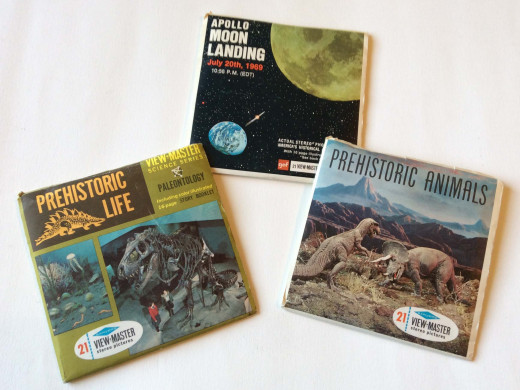
Educational Reels
Some reels featured educational topics. In the July 20, 1969 Apollo Moon Landing packet, we see historic scenes in 3-D of the Apollo 11 crew, Armstrong, Aldrin and Collins at a press conference, the historic liftoff, and the Grand Canyon, which looks tiny from Earth orbit. Other scenes show the huge building in which the Saturn V Apollo rocket was assembled as well as the 353-foot-tall craft being rolled to the launching pad on a giant transporter. A great, 3-D view of Mission Control shows the men at the banks of monitors used to guide the flight, and there is a 3-D view of the earthrise from the moon’s surface. There are also historic scenes in 2-D of the moon landing where a 3-D camera was not available.
The Prehistoric Animals packet includes 3D dioramas of the dinosaurs in realistic settings, while Prehistoric Life shows dinosaurs filling the large hall at Yale’s Peabody Museum and other scenes from museums of natural history. Various scenes show insects encased in amber, archaeologists digging for fossils, and museum experts reconstructing shattered fossils of a sabertooth tiger as well as fossilized trilobites and museum dioramas.
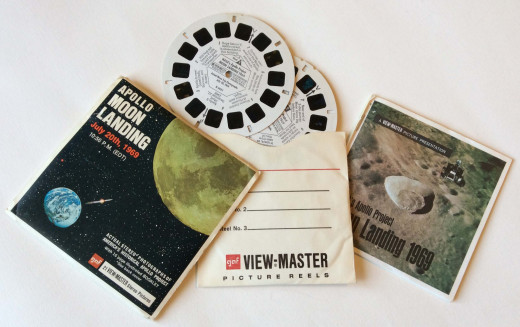
80's Commercial For The Classic Viewmaster
The View Through a View-Master
One thing I was surprised about when I hauled out my old View-Master for the first time in years was just how small and far away the images appeared to be.
Although View-Master reels typically featured excellent subject matter, superb photography and very good stereo, because the slides were so tiny and the magnification power of the lenses was not very great, the views were rather small and were surrounded by an inky blackness, as shown by the simulation below. The black surroundings gave you a feeling that you were viewing the slide in a darkened theater, but it also somewhat reduced the feeling of presence.
Another surprising difference between the View-Master and a modern virtual reality viewer is that I must use my glasses to see a sharp image with the View-Master, while I can take my glasses off with a virtual-reality headset.
Compare the below view with that of a modern smartphone virtual reality viewer (which, of course, not only provides stereo with full 360° panning, but movement and action as well) and you can see just how far viewing 3-D through a set of lenses has progressed over the years.
Simulated view through the View-Master

Simulated view through a modern smartphone VR headset
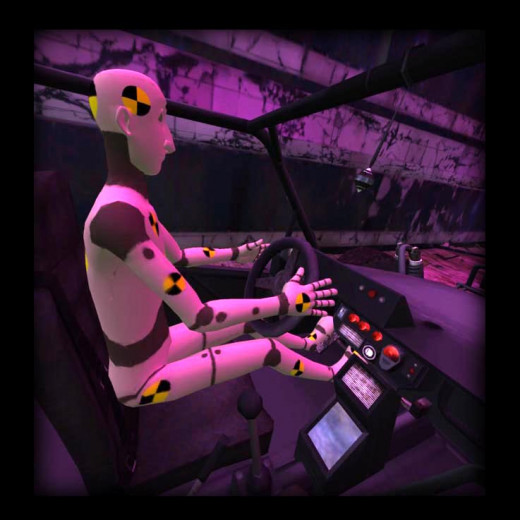
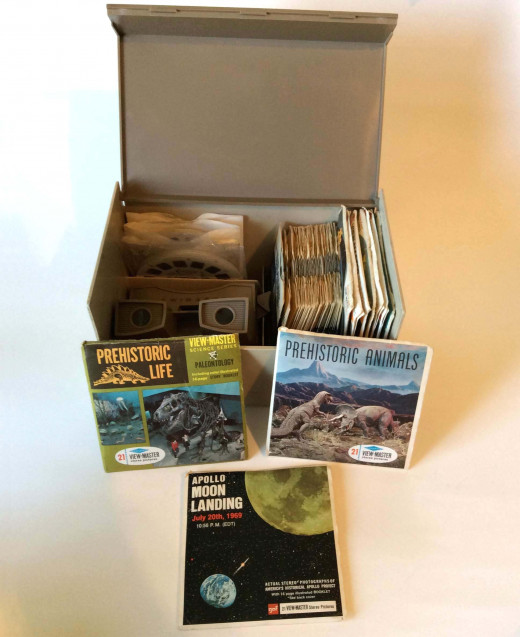
The Future of View-Master: Virtual Reality
Although this hub is called "Remembering the View-Master,” this does not mean the iconic device is gone or forgotten. In fact, View-Master, now owned by Mattel, is hard at work entering the digital age. In 2015, the toymaker teamed up with the likes of Google to create a View-Master virtual-reality device, which, not surprisingly, is based on Google Cardboard.
The device still uses the familiar circular cards, but rather than sliding them into the viewer, you slide in your smartphone. The cards come into play as objects at which to aim your smartphone’s camera, and they are encoded with a pattern that instructs the phone to display the desired 3-D image. The new View-Master is expected to be released in October.
Mattel and Google's View-Master Enters Virtual Reality

See My Other Hubs on Virtual Reality
- Virtual Reality on the iPhone
The best VR products and apps for the iPhone - Review: Homido VR Headset
Just how good is the Homido virtual reality headset for iPhone and Android?

